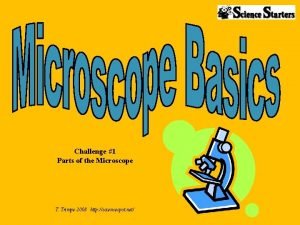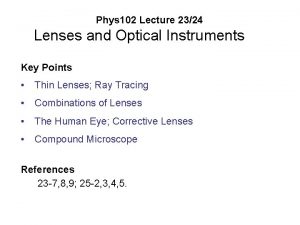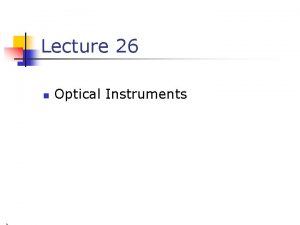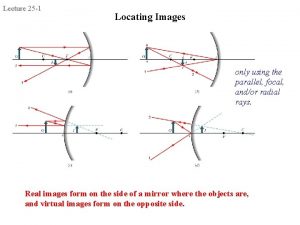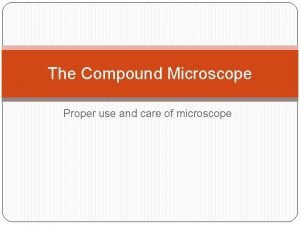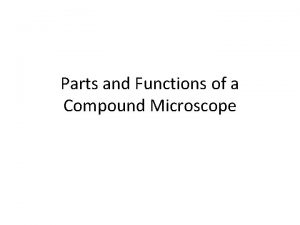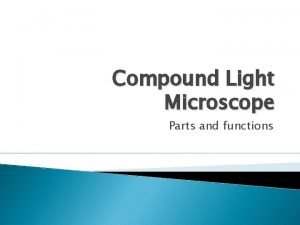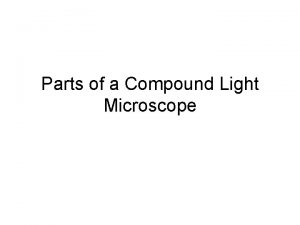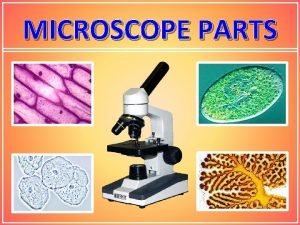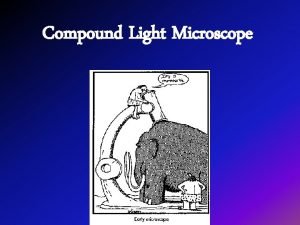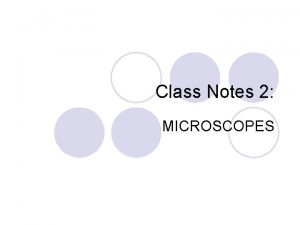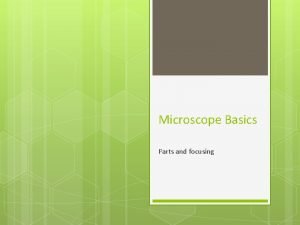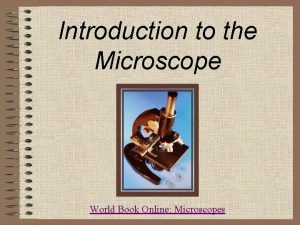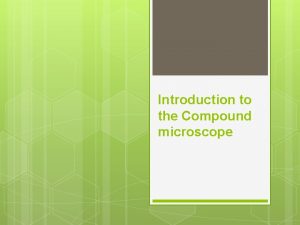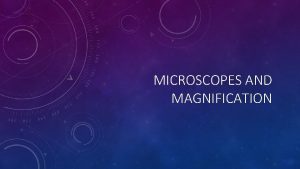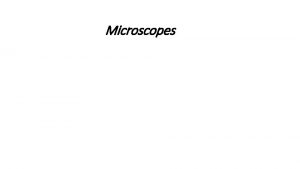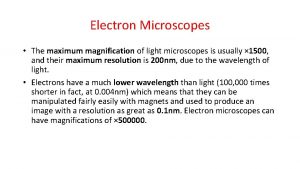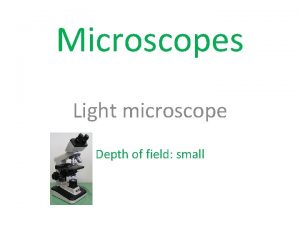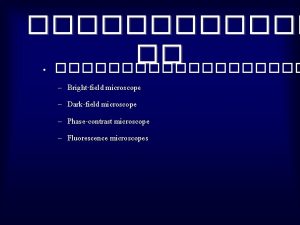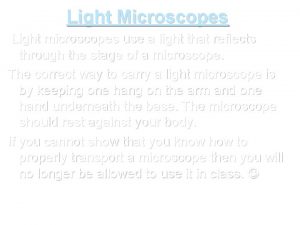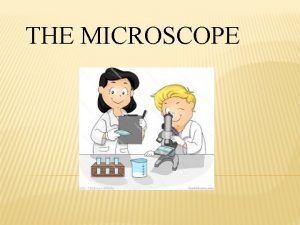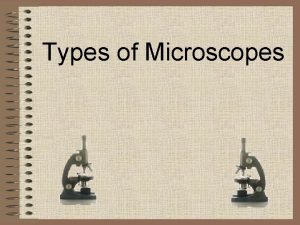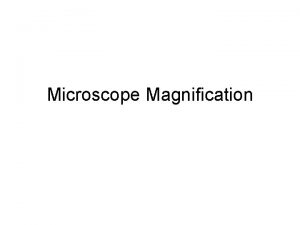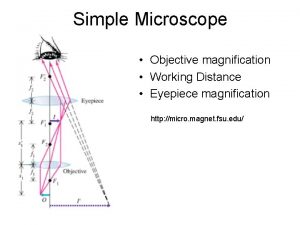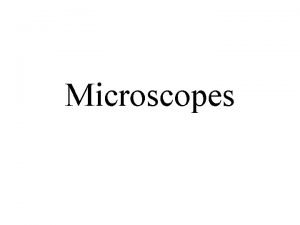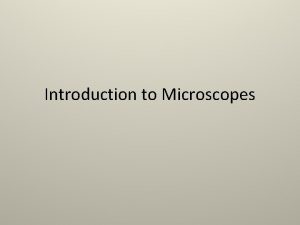MICROSCOPES AND MAGNIFICATION COMPOUND LIGHT MICROSCOPE In a














- Slides: 14

MICROSCOPES AND MAGNIFICATION

COMPOUND LIGHT MICROSCOPE • In a compound light microscope light must be able to pass through the specimen to see it enlarged. In a compound light microscope there are two lenses. Objects appear backwards and upside down. There are many parts to the compound microscope. A. Eye Piece – Located at the top of the microscope. This is the lens closest to your eye. B. Body Tube– Gives the distance needed between the eyepiece and the objective lenses.

COMPOUND LIGHT MICROSCOPE CONTINUED C. Course Adjustment Knob – Larger of the two knobs. Makes large adjustments in focusing D. Fine Adjustment Knob – Moves the body tube up and down, makes small adjustment in focusing. E. Nose Piece –rotating head that has the objectives attached to it. F. High Power Objective Lens – Largest objective lens, usually 40 x. Used for greatest magnification

COMPOUND LIGHT MICROSCOPE CONTINUED G. Low Power Objective Lens – Smallest objective lens, 4. 5 x used to scan for objects on the slide H. Arm – connects the base of the microscope with the nosepiece and ocular. Used for carrying. I. Stage – the specimen slide rests here, allows the light to pass through. J. Stage Clips – holds the slide in place on the stage.

COMPOUND LIGHT MICROSCOPE CONTINUED K. Diaphragm– Circular disk that adjusts the amount of light entering the stage area. L. Light Source – Reflects light or produces light from a bulb. M. Base – Holds up the entire microscope.

II. FOCUSING A COMPOUND MICROSCOPE • There is a proper way to focus a microscope. If you do not follow this procedure, you may damage the slide or the microscope. A. Carry your microscope with one hand on the arm and the other under the base. B. Place your slide on the stage and keep in place with the stage clips. Do not snap the clips down, as you can break them or the slide. C. Adjust the diaphragm so the proper amount of light is coming through.

II. FOCUSING A COMPOUND MICROSCOPE CONTINUED D. Make sure you are on the lowest power objective. E. Look at the objective from the side and use the course adjustment knobs to lower it until is as close as possible to the slide. F. When the specimen is in view, use the fine adjustment knob to bring it clearly in focus.

II. FOCUSING A COMPOUND MICROSCOPE CONTINUED G. When changing to the high power objective, rotate the nosepiece so the high power objective is over the slide. USE ONLY THE FINE ADJUSTMENT KNOB!!!!! NEVER USE THE COURSE ADJUSTMENT KNOB!!!! H. When done with the microscope, store it by lowering the stage and putting low power back. Make sure the light is off.

III MAKING A WET MOUNT SLIDE A. Obtain a clean slide and cover slip. B. Place the specimen in the middle of the slide. C. With a dropper, add one drop of water. D. Hold the cover slip by its edges. E. Lower it slowly, at an angle so air bubbles do not get trapped.

III MAKING A WET MOUNT SLIDE F. If air bubbles are trapped beneath the cover slip, try again. G. Remove any excess water with a piece of paper towel. H. Place the slide on the stage and view.

IV MAKING A WET MOUNT STAIN A. Make a wet mount slide. B. Using a dropper, add a drop of stain along the edge of the cover slip. C. Touch a paper towel on the opposite edge so as to draw the stain under the cover slip. D. Place the slide on the stage and view.

V. DISSECTING OR STEREOMICROSCOPE • The dissecting microscope allows you to see in 3 D. • Objects appear, as they seem in real life.

VI. ELECTRON MICROSCOPE • Electron microscopes can produce magnifications of more than 10, 000 x of light. To view a specimen it must be placed in plastic and cut into very thin slices. One disadvantage of this microscope is that it is very expensive

VII. MAGNIFICATION • Magnification is the ability to _make objects appear larger. Resolution is the crispness of the image. • In order to calculate total magnification the magnifying lenses have to be multiplied. Ex: objective lens X eyepiece. 40 X 10 = 400
 Microscope mania compound light microscope
Microscope mania compound light microscope Magnification of compound microscope formula
Magnification of compound microscope formula Hearing devices
Hearing devices Magnification of compound microscope
Magnification of compound microscope Care and structure of the compound microscope
Care and structure of the compound microscope Difference between light microscope and electron microscope
Difference between light microscope and electron microscope Base microscope function
Base microscope function Compound light microscope parts and functions
Compound light microscope parts and functions Mirror/lamp microscope
Mirror/lamp microscope Microscope parts
Microscope parts 40x
40x Parts of a light microscope
Parts of a light microscope Parts of the microscope
Parts of the microscope 1886 modern compound light microscope
1886 modern compound light microscope Compound light microscope definition
Compound light microscope definition
